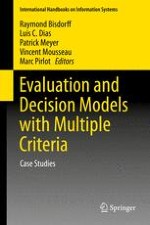2015 | Buch
Evaluation and Decision Models with Multiple Criteria
Case Studies
herausgegeben von: Raymond Bisdorff, Luis C. Dias, Patrick Meyer, Vincent Mousseau, Marc Pirlot
Verlag: Springer Berlin Heidelberg
Buchreihe : International Handbooks on Information Systems
